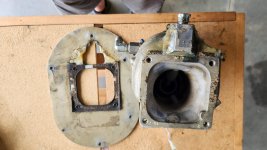dnickerson46
Member
-9A with an O-360-A1A.
The plate on the top of the airbox has a cutout for the bowl drain. Is there a better way to attach the airbox top plate so the bowl drain is accessible? I attached a picture. The builder filled in all around the cutout with RTV. Is this necessary? According to Marvel Schebler, good practice is to drain the carb bowl once a year during condition inspection.
I removed the carburetor for overhaul. It's been 20 years. The vent bowl gasket failed and caused a very poorly running engine.
The plate on the top of the airbox has a cutout for the bowl drain. Is there a better way to attach the airbox top plate so the bowl drain is accessible? I attached a picture. The builder filled in all around the cutout with RTV. Is this necessary? According to Marvel Schebler, good practice is to drain the carb bowl once a year during condition inspection.
I removed the carburetor for overhaul. It's been 20 years. The vent bowl gasket failed and caused a very poorly running engine.



